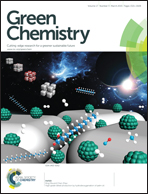Niobate salts of organic base catalyzed chemical fixation of carbon dioxide with epoxides to form cyclic carbonates†
Abstract
A series of peroxoniobate salts of amidine and guanidine were prepared successfully and utilized as halogen-free catalysts for the synthesis of cyclic carbonates from epoxides and CO2 under solvent-free and halide-free conditions. The reaction could be performed with high activity and selectivity with the assistance of the environmentally benign catalysts. CO2 could be chemically activated through an organic base dissociated from the parent catalyst during the reaction, while niobate anions played a crucial role in immobilizing catalytically active organic cations and thus improving the recyclability of the catalyst. The structural characterization of the catalysts indicated that peroxoniobate anions had undergone structural changes and were transformed into more stable niobate anions in the consecutive recycles. It was shown that the catalyst could be reused with high conversion and selectivity by a really straightforward process. Furthermore, this protocol was found to be applicable to a variety of epoxides producing the corresponding cyclic carbonates in high conversion and selectivity. The process herein represents a simple, ecologically friendly and efficient route for CO2 chemical fixation into high value chemicals.


 Please wait while we load your content...
Please wait while we load your content...